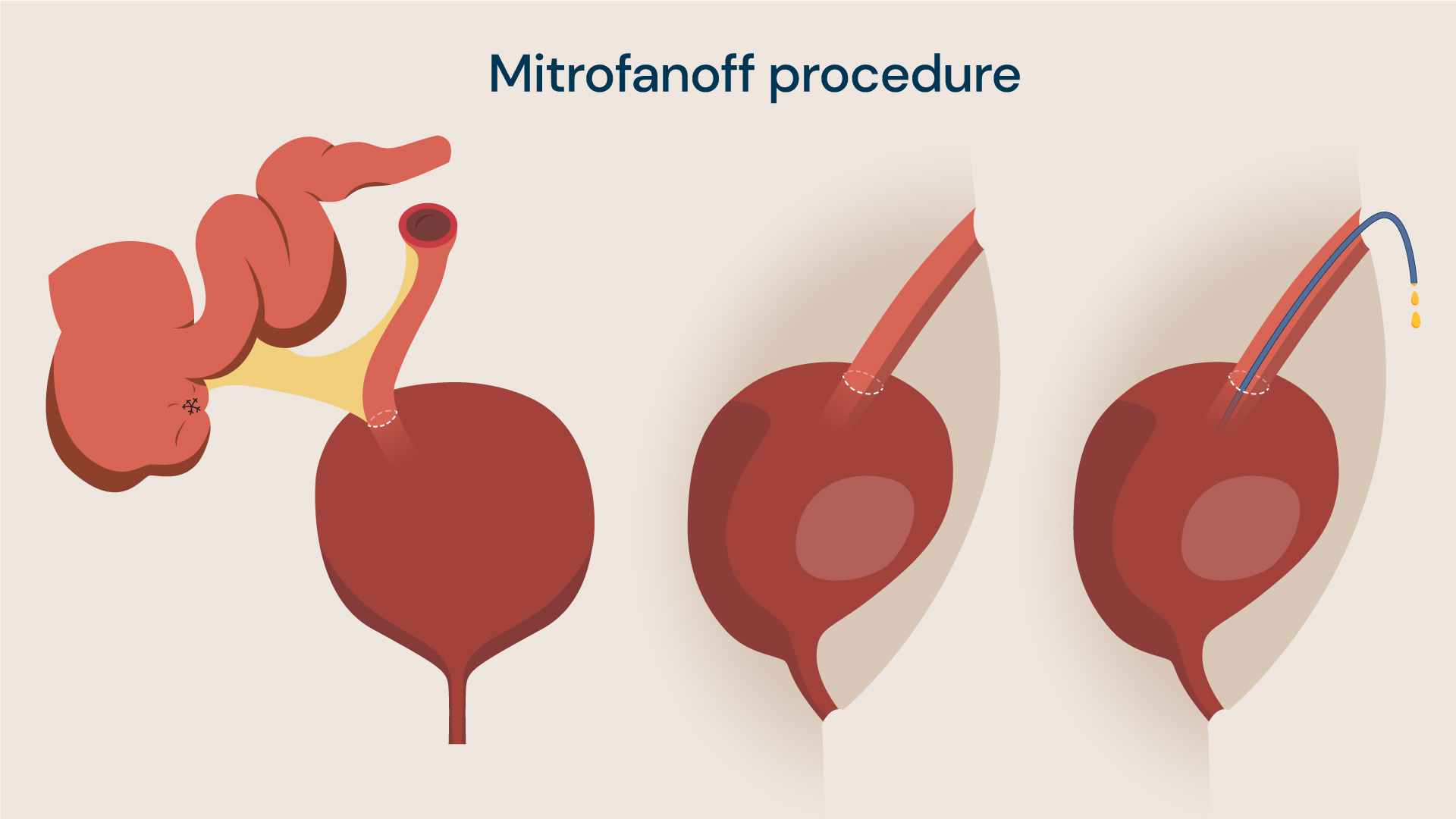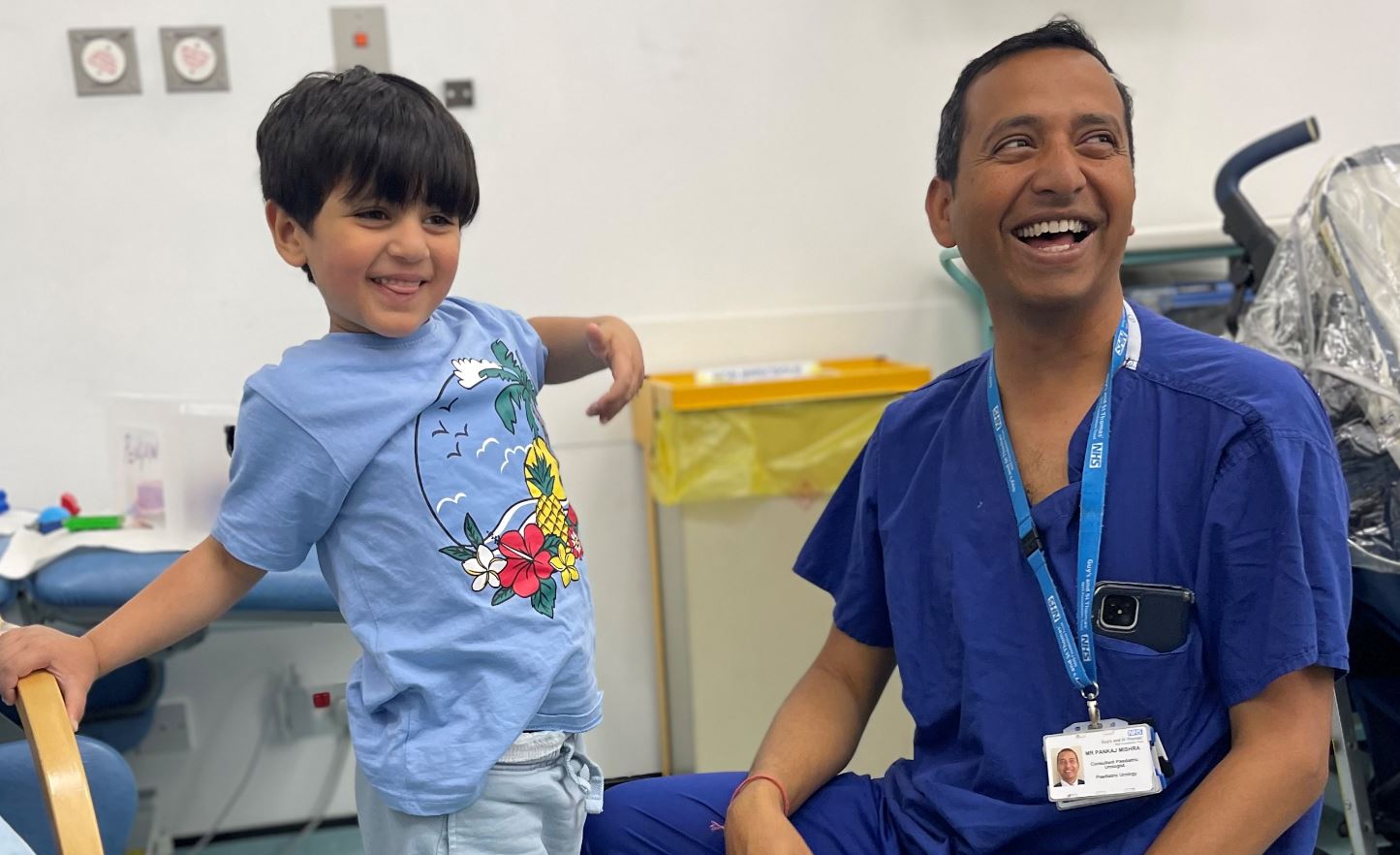Young patients with conditions that impact their bladder capacity or pressure may have poor kidney function, suffer with bladder leakage and experience regular urine infections. Our dedicated, multispecialty urology department at Evelina London Children’s Hospital offers a life-changing operation, bladder augmentation and the Mitrofanoff procedure, to treat these issues, keeping patients’ bladders safe and ensuring they are socially dry.
Conditions affecting bladder pressure and function
There are a number of conditions which can prevent patients from emptying their bladders fully, or which may lead to dangerously high bladder pressure, or bladder capacity which is too small. These conditions are often picked up before birth but sometimes present in young babies who have frequent urine infections as a symptom.
Common conditions which can lead to bladder problems include:
- posterior urethral valves (blockage in the urethra)
- spina bifida (and other spinal conditions)
- bladder and cloacal exstrophy
- anorectal abnormalities.
“Some of these abnormalities may mean that a patient has a very small bladder which is unable to cope with regular levels of urine,” explains Mr Pankaj Mishra, consultant paediatric urologist. “Alternatively, urine may be held in the bladder at a high pressure, triggering infection and, in some cases, leaking and causing kidney damage.”
Spinal conditions such as spina bifida can often mean that the nerves in patients’ spinal cords which are responsible for controlling the bladder did not form properly during pregnancy. Due to this, patients may struggle to store urine in their bladders, empty their bladders fully, or even be affected by both issues simultaneously.
What is the Mitrofanoff procedure?
Mitrofanoff is the name for a tube created from a patient’s appendix or small intestine which connects their bladder to the surface of the abdominal skin. The tube effectively creates a valve, preventing urine from leaking out of the bladder, so that the patient can control when the urine is drained by using a catheter. This improves their quality of life and allows them to be socially dry. It also minimises urine infections and kidney damage.
The Mitrofanoff procedure takes around three hours to perform and is carried out under general anaesthetic. In some cases, an additional procedure, a bladder augmentation, is performed at the same time to enlarge the bladder, increasing the capacity and therefore reducing the pressure at which urine is held.
“After having the procedure, the patient will need to pass a catheter into their bladder via the Mitrofanoff channel to drain urine,” explains Mr Mishra. This drainage is required around every three hours, or when the patient feels their bladder is full, and the catheter can be removed once the bladder is empty again.
“Catheterisation is a quick process and, when taught from a young age, children are able to adapt well and perform it independently,” notes Mr Mishra. “Most of our young patients pick this up well with the help of our specialist nurses and play therapists in Evelina London.”

A tube is created from the appendix or small intestine (left) which connects the bladder to the outer abdominal wall (middle), allowing urine to be drained through a catheter (right)
What is a bladder augmentation?
If a bladder augmentation is required, the surgeon opens the bladder during surgery to form a cup-like shape. Using bowel tissue, a lid-like structure is created and joined to the top of the bladder, essentially creating a larger bladder for the patient.
Having a larger bladder to store urine helps to reduce the pressure at which urine is held, making the patient more comfortable, while also reducing their likelihood of infection and kidney damage.

The bladder (left) is opened up during the procedure (middle) and a piece of bowel tissue is stitched onto the bladder to increase its size and capacity (right)
Case study: 5-year-old Abdullah
A young patient, Abdullah, visited Evelina London from Kuwait for treatment after he was referred by the Kuwait Health Office. Abdullah was diagnosed with a posterior urethral valve before birth when a pregnancy scan showed an enlargement of his bladder. Due to this blockage, his left kidney was not functioning properly, and he experienced regular infections as a result.
To treat Abdullah, a urinary diversion procedure (urinary stoma) was performed, preventing kidney damage. He also experienced urine going back into the kidneys due to a diverticulum (outpouching on the bladder), so he had the diverticulum removed during the same procedure which created his Mitrofanoff channel.
Prior to having treatment, the obstruction of the urinary tract impacted all aspects of Abdullah’s life; he was unable to attend school or join clubs as he had no control over his urine output, resulting in constant leakage of urine onto his clothes. Following the procedure, Abdullah is now leading a happy life, enjoying playing football and riding his scooter.
“Evelina London is one of the best hospitals in terms of comprehensive care, sophisticated equipment and a highly experienced medical team. Mr Mishra is one of the best doctors in his field and we highly recommend Evelina London,” said Abdullah’s parents.

Abdullah with Mr Mishra at Evelina London Children’s Hospital
When to refer to us
The Mitrofanoff procedure and bladder augmentation should be considered as an ultimate viable treatment option for patients with conditions which cause a small bladder with high bladder pressure, leading to infections and kidney damage.
Patients can be referred at any age, and even prenatally should a condition be detected before birth. Our expert team at Evelina London is one of the few in the UK that can perform this complex procedure, and we can smoothly manage the transition to adult care at adjoining St Thomas’ Hospital if required further down the line.
Get in touch
For more information on the Mitrofanoff procedure, bladder augmentation, and our paediatric urology service, please contact our customer services team.
Related content
-
Boy with bladder problems plays football after life-changing operation
-
Children's urology
Our paediatric urology service provides specialist care for children with kidney, bladder and genitalia problems.
-
Mitrofanoff procedure and bladder augmentation in children
The Mitrofanoff procedure is a treatment for children with bladder capacity and pressure issues leading to discomfort, infection, leakage and kidney damage.

